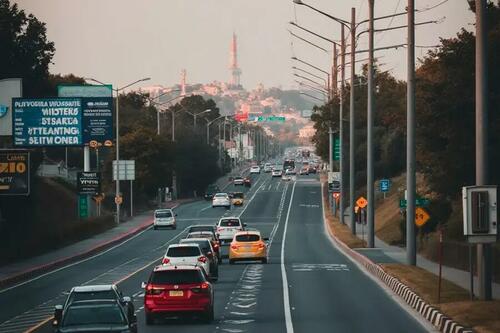Authored by Andria Pressel via The Epoch Times (emphasis ours),
As artificial intelligence (AI) continues to develop, it’s getting harder and harder to tell the difference between real photographs and AI-generated images.
AI can create everything from stunning landscapes to lifelike portraits in a matter of moments—and at first glance, they may appear perfectly legitimate.
In this age of misinformation, how can you discern if the images you’re seeing are real or fabricated?
Fortunately, there are subtle clues that can help us tell the difference, including inconsistencies in texture, anomalies in human features, and garbled writing. By understanding these telltale signs, you can better navigate digital information and assess the authenticity of the images you encounter.
1. Unnatural Hands and Limbs

Hands and limbs are surprisingly complex structures, and AI often struggles to accurately replicate them. Look for extra, oddly shaped, or misaligned fingers. They may also be positioned in an unusual way or have improper dimensions.
In the above image, the children’s hands and feet look unnatural, with misshapen fingers and toes as well as misaligned sandal straps.

2. Discrepancies in Details

AI has difficulty rendering small details, so you might also see objects and elements being subtly merged together in unnatural ways. These imperfections occur because AI relies on pattern recognition, which can fail when handling intricate or nuanced details.
So if you’re uncertain if a crowd photo is legitimate, take a look at the details. For example, background faces are often blurred or have soft, poorly defined characteristics.
In this AI-generated image, the man in the water has a blurry face and fingerless hands, while the young man on shore has a transparent leg that appears to merge into the background.

3. Overly Perfect Skin

Having an overly smooth face with very little texture is a sign of an AI-generated photo. Its lack of genuine texture and flaws can almost make the individual look comical.
In the above images, the girl on the left has extremely smooth skin and hair that blends in with her collar. The boy to the right also has skin that is too smooth.
4. Misalignments

AI can struggle with alignments, resulting in a disjointed or incoherent appearance because elements don’t align properly.
Objects may overlap in unnatural ways that defy spatial coherence.
Zoom in to spot inconsistencies, such as in the above image, where the lines of the wicker cut through the picnic items. The texture lines on the woven picnic basket and tray are misaligned.

5. Inconsistencies and Asymmetries in Small Details
Inconsistencies in minor things, such as glasses with mismatched lenses or frames, should be easy to notice.
Though they appear genuine at first glance, the following AI-generated photos from ThisPersonDoesNotExist.com have flaws that may be seen with closer examination.
The woman in the left image is wearing two completely different earrings.
The center image is betrayed as AI-generated by the left corner, where the man’s shirt blends with the background.
In the image on the far right, the endpieces of the glasses are mismatched.
6. Garbled Writing

AI-generated images often produce garbled or nonsensical text, with letters and words jumbled.
Take a close look at any writing or logos in the image to see if they are difficult to read or completely incoherent.
This image, produced by AI, depicts traffic on a crowded street. Upon closer inspection, you can see that the text on the roadside billboard is illegible.
7. Illogical Context

Read more here...
Authored by Andria Pressel via The Epoch Times (emphasis ours),
As artificial intelligence (AI) continues to develop, it’s getting harder and harder to tell the difference between real photographs and AI-generated images.
AI can create everything from stunning landscapes to lifelike portraits in a matter of moments—and at first glance, they may appear perfectly legitimate.
In this age of misinformation, how can you discern if the images you’re seeing are real or fabricated?
Fortunately, there are subtle clues that can help us tell the difference, including inconsistencies in texture, anomalies in human features, and garbled writing. By understanding these telltale signs, you can better navigate digital information and assess the authenticity of the images you encounter.
1. Unnatural Hands and Limbs

Hands and limbs are surprisingly complex structures, and AI often struggles to accurately replicate them. Look for extra, oddly shaped, or misaligned fingers. They may also be positioned in an unusual way or have improper dimensions.
In the above image, the children’s hands and feet look unnatural, with misshapen fingers and toes as well as misaligned sandal straps.

2. Discrepancies in Details

AI has difficulty rendering small details, so you might also see objects and elements being subtly merged together in unnatural ways. These imperfections occur because AI relies on pattern recognition, which can fail when handling intricate or nuanced details.
So if you’re uncertain if a crowd photo is legitimate, take a look at the details. For example, background faces are often blurred or have soft, poorly defined characteristics.
In this AI-generated image, the man in the water has a blurry face and fingerless hands, while the young man on shore has a transparent leg that appears to merge into the background.

3. Overly Perfect Skin

Having an overly smooth face with very little texture is a sign of an AI-generated photo. Its lack of genuine texture and flaws can almost make the individual look comical.
In the above images, the girl on the left has extremely smooth skin and hair that blends in with her collar. The boy to the right also has skin that is too smooth.
4. Misalignments

AI can struggle with alignments, resulting in a disjointed or incoherent appearance because elements don’t align properly.
Objects may overlap in unnatural ways that defy spatial coherence.
Zoom in to spot inconsistencies, such as in the above image, where the lines of the wicker cut through the picnic items. The texture lines on the woven picnic basket and tray are misaligned.

5. Inconsistencies and Asymmetries in Small Details
Inconsistencies in minor things, such as glasses with mismatched lenses or frames, should be easy to notice.
Though they appear genuine at first glance, the following AI-generated photos from ThisPersonDoesNotExist.com have flaws that may be seen with closer examination.
The woman in the left image is wearing two completely different earrings.
The center image is betrayed as AI-generated by the left corner, where the man’s shirt blends with the background.
In the image on the far right, the endpieces of the glasses are mismatched.
6. Garbled Writing

AI-generated images often produce garbled or nonsensical text, with letters and words jumbled.
Take a close look at any writing or logos in the image to see if they are difficult to read or completely incoherent.
This image, produced by AI, depicts traffic on a crowded street. Upon closer inspection, you can see that the text on the roadside billboard is illegible.
7. Illogical Context

Read more here...


